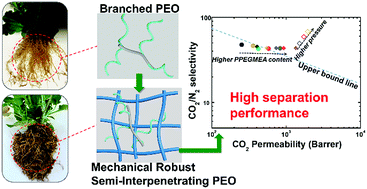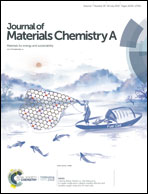Penetrating chains mimicking plant root branching to build mechanically robust, ultra-stable CO2-philic membranes for superior carbon capture†
Abstract
Rubbery CO2-philic membranes are a promising strategy for both carbon capture and hydrogen purification to meet the increasing demands of low-carbon technology owing to their preferable/fast CO2 transport and their inherently low-energy consumption. An excellent molecular chain mobility and sufficient structural softness are the keys to obtaining highly-permeable rubbery polyethylene oxide (PEO) membranes, but these properties also bring about the problem of a low mechanical strength, creating the contradiction of high permeability and the structural stability of the rubbery PEO membranes. Herein, a win–win method is presented to mimic multi-functional plant roots to branch penetrating chains with a millipede-like architecture inside CO2-philic network membranes for the simultaneous enhancement of the membrane mechanical properties, structural stability and gas transportation in one stroke. Our novel penetrating-chain-branched CO2-philic membranes exhibits improved tensile strength, better elasticity, an excellent long-term stability and ultrahigh gas permeability. The tensile strength of the membrane can be improved by up to 1.6 fold. The highest CO2 permeability reaches 1952 Barrer (increased by 363% compared to the pristine cross-linked PEO) with a high CO2/light gas selectivity (16.0 for CO2/H2 and 70.6 for CO2/N2), readily surpassing the “Robeson's upper bound” limits.



 Please wait while we load your content...
Please wait while we load your content...